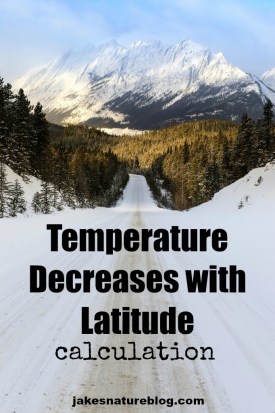 Temperature decreases with latitude, just like temperature decreases if you go up in elevation. Here is some more info and an explanation about this.
Temperature decreases with latitude, just like temperature decreases if you go up in elevation. Here is some more info and an explanation about this.
I find it fascinating that traveling north from the equator is somewhat similar to traveling up in elevation. I know that marmots and other hardy animals live at the tops of mountains in the alpine areas. But, those same animals live at lower elevations and the tree line is lower in northern Montana and Canada.
Comparison Of Temperature Decreases With Latitude And Elevation
When you go up in elevation the temperature decreases and this impacts the types of plants and animals that live there. There is a simple calculation that you can use to determine what the temperature decrease will be as you go up in elevation.
Additionally, when you go north in latitude from the middle Rockies of Colorado to the Northern Rockies of Canada the temperature decreases with latitude and the animals and plants also change.
Calculation Of Temperature Decreases With Latitude
Here is a basic calculation to help you determine the temperature change as you go north in latitude away from the equator. For every 300 miles you travel north it will be 3 degrees F colder.
For example, a spot 600 miles north will be 6 degrees F colder than where you are.
Example Of How Temperature Decreases With Latitude Impacts Animals And Plants Habitats
Tree line is a good example of how moving north in latitude is similar to moving up in elevation. Tree line in the southern Rockies in New Mexico is at about 12,000 feet. But, as you move north in latitude the elevation of tree line drops. Glacier National Park in northern Montana has a tree line of around 6,900 feet. Then all the way up in the Brooks range of Alaska the tree line drops to about 2,500 feet.

A yellow bellied marmot.
Marmots are tough, hardy animals that live in and above tree line. There are several different species, but they also change with elevation and latitude. The yellow-bellied marmot is common in the middle Rocky Mountains of Colorado.
However, as you move north you can also find the Hoary Marmot. The Hoary Marmot lives in the Canadian Rockies. Where these two species overlap in their range the Hoary Marmot lives at higher elevations. This indicates that they are better adapted to survive at higher elevations. But, they also live farther north in latitude.
